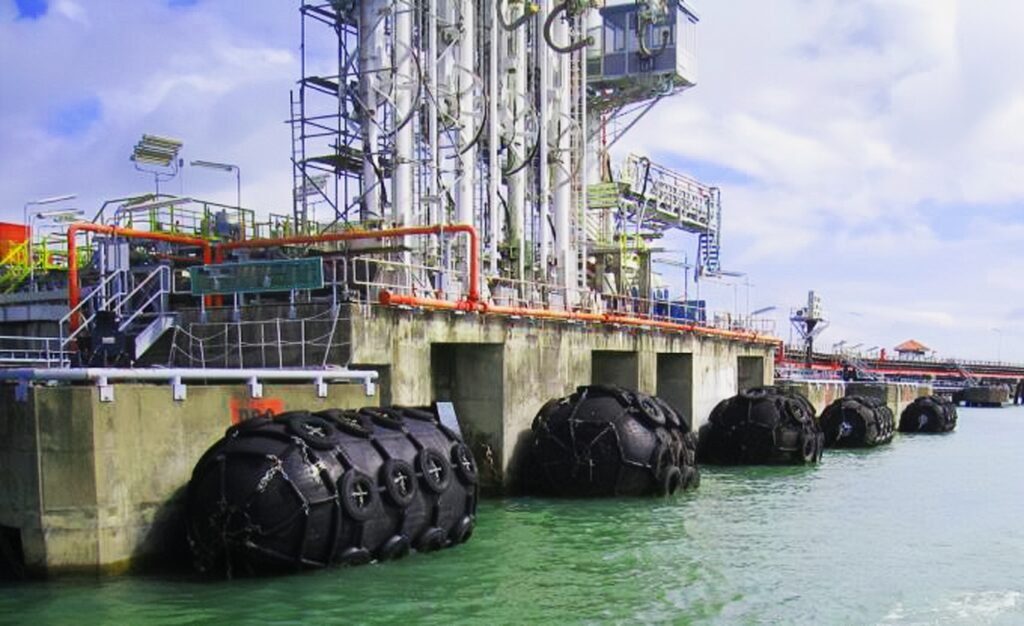When people ask whether yokohama rubber fenders can be used offshore, the quick answer is yes. In fact, operators around the world rely on them for ship-to-ship (STS) transfers, FPSO offloading, and offshore terminals. Because they combine high energy absorption with low reaction force, and because they float with waves, they perform extremely well in offshore environments.

What Are Yokohama Rubber Fenders?
To understand their offshore role, let’s first look at their structure. Yokohama rubber fenders are a type of pneumatic fender. Manufacturers build them with three main layers: an inner rubber tube, multiple synthetic cord layers for strength, and an outer rubber cover. End flanges and valves allow easy inflation and pressure control.
Moreover, two common styles exist offshore:
- Sling type – lightweight, simple to deploy
- Chain-tire-net (CTN) type – covered with chains and tires, which provide stronger abrasion resistance
In addition, operators choose between 50 kPa and 80 kPa pressure classes, depending on energy absorption needs. Large offshore operations often use fenders such as 2.5×4.0 m or 3.3×6.5 m sizes.
Offshore Scenarios Where They Excel
1. Ship-to-Ship (STS) Transfers
During STS transfers of crude oil or refined products, ships must keep a safe distance. Yokohama fenders absorb energy and maintain clearance, even when swell or surge affects vessel motion. As a result, they help reduce hull stress and improve safety.
2. FPSO and FSU Offloading
When shuttle tankers moor alongside FPSOs, pneumatic fenders provide a stable buffer. Because they remain buoyant, they adjust with wave action and protect both units during offloading.
3. SPM and CBM Mooring
At offshore buoy terminals, fenders ensure proper standoff. In addition, they give tankers extra protection during loading or waiting periods.
4. Offshore Platforms & Wind Farms
Supply boats and crew transfer vessels also use Yokohama fenders. In these cases, smaller sizes make docking with floating or fixed structures safer.
On the other hand, if vessels need protection at submerged contact points, hydropneumatic fenders may be a better option.
Why They Suit Offshore Conditions
There are several reasons why yokohama rubber fenders perform so well offshore:
- Buoyancy: They float with the tide and swell, so they maintain a stable contact line.
- High Energy Absorption (EA): They cushion hulls against dynamic impact.
- Low Reaction Force: They protect vessels by reducing stress.
- Durability: CTN adds abrasion resistance for harsh environments.
- Safety: Valves release pressure safely under overload.
Therefore, many offshore operators consider them the first choice for demanding operations.
How to Select the Right Fender
When selecting a fender, operators should not guess. Instead, they should carefully evaluate:
- Vessel displacement and size
- Approach speed and environmental conditions
- Hull curvature, draft, and freeboard
- Type – CTN for heavy-duty, sling type for lighter tasks
- Pressure class – 50 kPa for general use, 80 kPa for higher energy demands
For example, a 150,000 DWT tanker in STS service often uses 3.3×6.5 m CTN fenders at 50 kPa. Consequently, both safety and efficiency improve.
Standards & Compliance
To operate offshore safely, companies should only use fenders that comply with ISO 17357-1. In fact, most charterers and terminals require this certification. Therefore, checking compliance before deployment saves both time and risk.
Rigging & Deployment Offshore
Deploying fenders correctly makes a big difference. Operators usually rig them with:
- Chains, shackles, and wire pendants
- Pick-up gear for workboat handling
- Protective chafing gear to prevent hull damage
In addition, proper positioning avoids problems with prop wash and snagging. As a result, the fender performs as intended.
Inspection & Maintenance
Unlike solid rubber fenders, pneumatic types need regular checks. Operators should:
- Measure internal pressure before each use
- Inspect valves, chains, and tire nets
- Record pressure logs during long campaigns
- Store them in shaded areas to reduce UV damage
By keeping this routine, crews extend fender life and avoid costly downtime.
Limitations & Alternatives
While highly versatile, yokohama rubber fenders are not perfect in every situation. For instance, in icy seas, they may require special covers. In very tight berths, operators sometimes prefer foam-filled fenders or solid rubber options. Moreover, environmental concerns about discarded tires can make sling-type fenders a cleaner alternative.
FAQs About Yokohama Rubber Fenders Offshore
1. Are Yokohama rubber fenders the same as pneumatic fenders?
Yes. The name “Yokohama fender” comes from the original brand, but it refers to pneumatic fenders in general.
2. Can they handle all vessel sizes?
Yes. With correct sizing, they work from small OSVs to VLCCs.
3. What’s the difference between 50 kPa and 80 kPa?
50 kPa suits most offshore cases, while 80 kPa offers higher energy absorption for extreme conditions.
4. Do I need CTN or sling type offshore?
CTN is recommended for heavy-duty offshore tasks, while sling type is lighter and easier for small vessels.
5. How often should I check pressure?
Crews should check before each operation and at least once a week during extended campaigns.
Conclusion
So, can yokohama rubber fenders be used offshore? Definitely. They are the global standard for STS transfers, FPSO operations, and buoy moorings. Moreover, they provide high energy absorption, low reaction force, and reliable buoyancy in rough seas.
By choosing the right type, pressure class, and rigging, operators can ensure safe, efficient, and long-lasting offshore operations.


